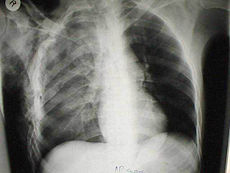- Flail chest
-
Flail chest Classification and external resources 
A chest radiograph of a flail chest associated with right sided pulmonary contusion and subcutaneous emphysemaICD-10 S22.5 ICD-9 807.4 DiseasesDB 32227 eMedicine med/2813 MeSH D005409 A flail chest is a life-threatening medical condition that occurs when a segment of the rib cage breaks under extreme stress and becomes detached from the rest of the chest wall. It occurs when multiple adjacent ribs are broken in multiple places, separating a segment, so a part of the chest wall moves independently. The number of ribs that must be broken varies by differing definitions: some sources say at least two adjacent ribs are broken in at least two places,[1] some require three or more ribs in two or more places.[2] The flail segment moves in the opposite direction as the rest of the chest wall: because of the ambient pressure in comparison to the pressure inside the lungs, it goes in while the rest of the chest is moving out, and vice versa. This so-called "paradoxical motion" can increase the work and pain involved in breathing. Studies have found that up to half of people with flail chest die. Flail chest is invariably accompanied by pulmonary contusion, a bruise of the lung tissue that can interfere with blood oxygenation.[3] Often, it is the contusion, not the flail segment, that is the main cause of respiratory failure in patients with both injuries.[4]
Contents
Signs and symptoms
The characteristic paradoxical motion of the flail segment occurs due to pressure changes associated with respiration that the rib cage normally resists:
- During normal inspiration, the diaphragm contracts and intercostal muscles push the rib cage out. Pressure in the thorax decreases below atmospheric pressure, and air rushes in through the trachea. However, a flail segment will not resist the decreased pressure and will appear to push in while the rest of the rib cage expands.
- During normal expiration, the diaphragm and intercostal muscles relax, allowing the abdominal organs to push air upwards and out of the thorax. However, a flail segment will also be pushed out while the rest of the rib cage contracts.
The constant motion of the ribs in the flail segment at the site of the fracture is incredibly painful, and, untreated, the sharp broken edges of the ribs are likely to eventually puncture the pleural sac and lung, possibly causing a pneumothorax. The concern about "mediastinal flutter" (the shift of the mediastinum with paradoxical diaphragm movement) does not appear to be merited.[5]
Causes
Flail chest is a serious, life-threatening chest injury often associated with underlying pulmonary injury and is most commonly seen in cases of significant blunt trauma. In emergency department presentations, approximately 30% of patients with extensive thoracic trauma have a flail chest.[1]
This typically occurs when three or more adjacent ribs are fractured in two or more places, allowing that segment of the thoracic wall to displace and move independently of the rest of the chest wall. Flail chest can also occur when ribs are fractured proximally in conjunction with disarticulation of costal cartilages distally. For the condition to occur, generally there must be a significant force applied over a large surface of the thorax to create the multiple anterior and posterior rib fractures. Rollover and crushing injuries most commonly break ribs at only one point– for flail chest to occur a significant impact is required, breaking the ribs in two or more places.[6]
Treatment
Treatment of the flail chest initially follows the principles of Advanced Trauma Life Support. Further treatment includes:
- Good analgesia including intercostal blocks, avoiding narcotic analgesics as much as possible. This allows much better ventilation, with improved tidal volume, and increased blood oxygenation.
- Positive pressure ventilation, meticulously adjusting the ventilator settings to avoid pulmonary barotrauma.
- Chest tubes as required.
- Adjustment of position to make the patient most comfortable and provide relief of pain.
- Aggressive pulmonary toilet
Surgical fixation can help in significantly reducing the duration of ventilatory support and in conserving the pulmonary function.[7]
A patient may be intubated with a double lumen tracheal tube. In a double lumen endotracheal tube, each lumen may be connected to a different ventilator. Usually one side of the chest is affected more than the other, so each lung may require drastically different pressures and flows to adequately ventilate.
References
- ^ a b Emergency Nurses Association; Lorene Newberry (ed), Laura M. Criddle (ed) (2005). Sheehy's Manual of Emergency Care (6th ed.). St Louis, Missouri: Elsevier Mosby. pp. 655–657.
- ^ Keel M, Meier C (December 2007). "Chest injuries - what is new?". Current Opinion in Critical Care 13 (6): 674–9. doi:10.1097/MCC.0b013e3282f1fe71. PMID 17975389.
- ^ Yamamoto L, Schroeder C, Morley D, Beliveau C (2005). "Thoracic trauma: The deadly dozen". Critical Care Nursing Quarterly 28 (1): 22–40. PMID 15732422.
- ^ Hemmila MR, Wahl WL (2005). "Management of the injured patient". In Doherty GM. Current Surgical Diagnosis and Treatment. McGraw-Hill Medical. pp. 214. ISBN 0-07-142315-X. http://books.google.com/?id=c3I-PFkMN2YC&pg=PA863&dq=%22level+of+consciousness%22. Retrieved 2008-07-04.
- ^ Molnar TF (2007). "(Video Assisted) thoracoscopic surgery: Getting started". J Minim Access Surg 3 (4): 173–7. doi:10.4103/0972-9941.38912. PMC 2749201. PMID 19789679. http://www.pubmedcentral.nih.gov/articlerender.fcgi?tool=pmcentrez&artid=2749201.
- ^ Bjerke, H Scott (2006-06-16). "Flail Chest". eMedicine. http://www.emedicine.com/med/topic2813.htm. Retrieved 2007-08-01.
- ^ Granetzny A; Abd El-Aal, M; Emam, E; Shalaby, A; Boseila, A (2005). "Surgical versus conservative treatment of flail chest. Evaluation of the pulmonary status". Interact Cardiovasc Thorac Surg 4 (6): 583–7. doi:10.1510/icvts.2005.111807. PMID 17670487.
External links
- Trauma.org - Trauma Surgery, Injury & Critical Care (info, images, and video of paradoxical flail-segment motion).
- Video of a flail chest
Injury : Fractures and cartilage injuries (Sx2, 800–829) General Head Vertebral Spinal fractureRibs Shoulder, arm
and handShoulderArmHandHip, leg and foot Hip/femurLegFootCategories:
Wikimedia Foundation. 2010.

